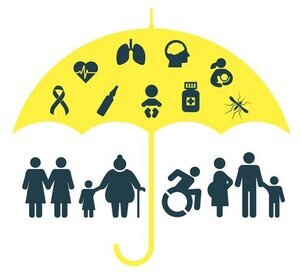UHC2030 hosted its annual UHC Day parliamentarian town hall to...
8 March 2024
This International Women's Day (March 8), the Coalition of Partnerships for UHC and Global Health and the Alliance for Gender Equality and UHC are calling for countries to take a gender-responsive approach to achieve universal health coverage (UHC).

Authors: Angeli Achrekar, Svetlana Akselrod, Helen Clark, Gabriela Cuevas Barron, Michael Charles, Katie Dain, Roopa Dhatt, Maliha Khan, Justin Koonin, Ilayda Orankoy, Swostika Thapaliya, Chantal Umuhoza
This article was first published in The Lancet Global Health
This International Women's Day (March 8), the Coalition of Partnerships for UHC and Global Health and the Alliance for Gender Equality and UHC are calling for countries to take a gender-responsive approach to achieve universal health coverage (UHC). UHC can only be achieved when gender inequalities and other drivers of inequality within and beyond health systems are addressed.
Gender equality includes equal rights and equitable access to health services, for all individuals in all their diversity, and is fundamental to UHC. According to WHO, UHC means that all people have access to the full range of quality health services they need, when and where they need them, without financial hardship. UHC is central to achieving Sustainable Development Goal 3 (SDG 3) and embodies a transformative force for the entire 2030 Agenda. In the 2019 and 2023 UN Political Declarations on UHC, Member States recognised that gender equality is critical for UHC and that UHC will in turn empower women and girls and strengthen gender equality, development, economies, and contribute to peaceful and inclusive societies.
Since the COVID-19 pandemic—which has widened pre-existing inequality gaps, including gender inequality, and reversed progress on sustainable development—it is now estimated that it will take the world 286 years to achieve gender equality.1 Moreover, UHC2030's latest State of UHC Commitment review2 shows that UHC processes are still gender-blind and there continues to be a lack of commitment to increase women's representation in health and political leadership.
Gender is a critical social determinant of health and intersecting gender inequalities reduce people's access to health services and in turn put their health and wellbeing at risk.1 Gender norms, roles, and differentials in power relations and in control over resources contribute to differences in vulnerabilities and susceptibility to illness, health behaviours, uptake of health services, treatment responses, and health outcomes. Attention to the persistent differences between men's and women's and boys' and girls' health risks, health status, and access to services will improve the performance of health systems. Without an explicit focus on their holistic health needs, UHC targets will not be met.3
Women and adolescent girls all over the world are dying from preventable causes during pregnancy, childbirth, and unsafe abortions, and from lack of autonomy to make their own health decisions. According to UNAIDS, women and girls accounted for about 60% of the African region's new HIV infections in 2021 and new HIV infections are three times higher among girls and women aged 15–24 years old than among males of the same age.4 Globally, two in every three deaths among all women are due to non-communicable diseases, for a total of approximately 19 million deaths annually.5
To achieve UHC and the sustainable development agenda, health systems strengthening efforts must be gender-responsive and equitable. They must proactively confront gender bias and discrimination, be informed by both sex-disaggregated and gender-disaggregated data, and address gender inequality in the health and care workforce and in political leadership. Women and adolescent girls are best placed to articulate their own needs and define how these can be met across their life course. Governments need to ensure that women and girls are well represented in health and political leadership and that diverse voices and perspectives are elevated and included in UHC decision-making processes at all levels. Safe, decent, and equal work for women health and care workers must be invested in and women's, adolescents', and girls' sexual and reproductive health needs must be incorporated into essential benefits packages. It must be ensured that no one faces barriers to access or stigma when accessing care based on their gender identity or sexual orientation. Only then can we accelerate progress on gender equality and ensure health for all.
Health systems that are not gender responsive will fail. The Coalition of Partnerships for UHC and Global Health and the Alliance for Gender Equality and UHC support ongoing efforts by UHC2030 in collaboration with the Alliance for Gender Equality and UHC and the Partnership for Maternal, Newborn, and Child Health and commit to calling for and supporting a world where all people, especially women and girls, in all their diversity, are able to access, use, and benefit from gender-responsive health systems.
We declare no competing interests. We thank Neena Joshi, Bethany-Kate Lewis, and Laetitia Bosio for their support in drafting and editing this Comment.
References
- UN Women. Progress on the Sustainable Development Goals: the gender snapshot. Date: 2022. Date accessed: March 5, 2024
- UHC2030. State of UHC commitment. Date accessed: March 5, 2024
- Rodin J. Accelerating action towards universal health coverage by applying a gender lens. Bull World Health Organ. 2013; 91: 710-711
- UNAIDS. Data 2022. Geneva: Joint United Nations Programme on HIV/AIDS. Date accessed: March 5, 2024
- NCD Alliance. Women and NCDs. Date accessed: March 5, 2024
More UHC2030 News
A global health financing emergency threatens progress toward...
UHC2030 at HSR2024: Advancing equity and inclusion in health systems through civil society knowledge
UHC2030, in collaboration with the SUPPORT-SYSTEMS research...
